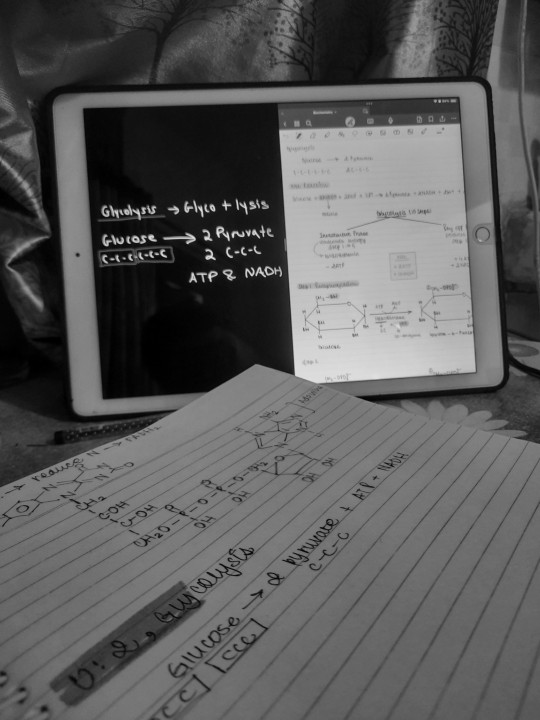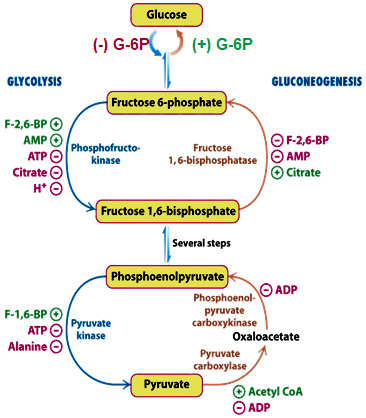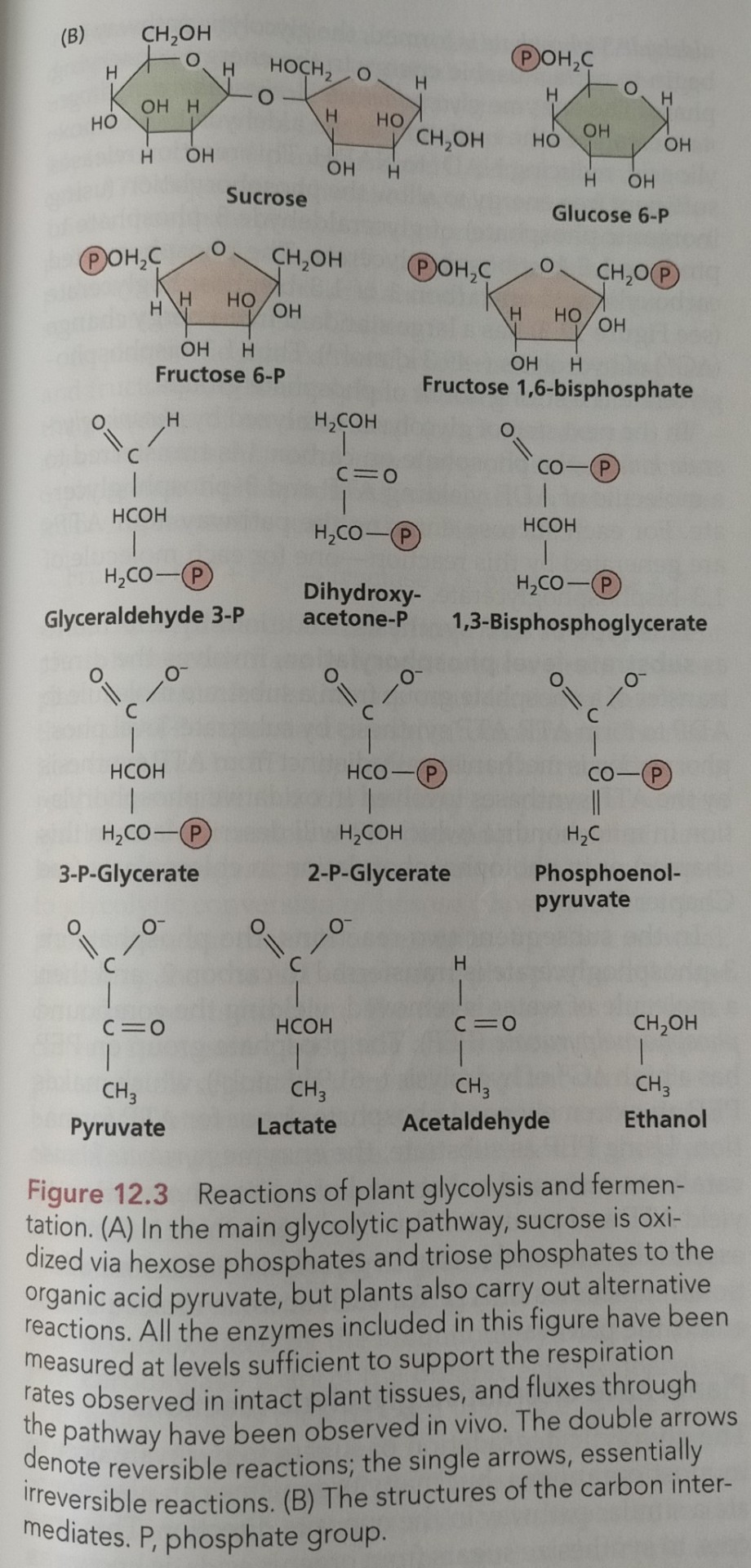#glycolysis
Text
Ultimate Word Tournament!
glycolysis (English, Biology Dialect)
[glaɪˈkɒləsɪs]
the breakdown of glucose by enzymes, releasing energy and pyruvic acid
ire (English)
[aɪɹ]
Anger, often an intense anger.
Ire Propaganda
266 notes
·
View notes
Text

every single time
#krebs cycle#glycolysis#biology meme#biochemistry#the joke is that no matter how many times i learn it i have to relearn it every time i have an exam for it#i know the concept but i never memorised all the reactions and enzymes and steps
278 notes
·
View notes
Text


21/25 Days of Productivity
Writing notes of Glycolysis. Block 1 of Metabolism has soo many cycles I'm thrilled to learn all of them!
🎧 : Aigiri Nandini, Shankar Mahadevan
#original#25 dop#30dopwithcleo#stem academia#chaotic academia#heypeachblossom#studyblr#problematicprocrastinator#chazzastudiesalevels#heydilli#heygather#linksstudyblr#septemberstudies#meestudies#heysantiago#heychemblr#heychenleyah#medblr#glycolysis#study notes#productivity#motivation#study challenge
58 notes
·
View notes
Text
All right @respectthepetty, what's the love story happening here?

#(no pressure to answer of course. I just immediately thought of you when I read it)#color coded [metabolic processes] in love#conversations with respectthepetty#gillianthecat goes back to school#hw lb#from my textbook#cellular respiration#glycolysis#pyruvate oxidation#citric acid cycle#oxidative phosphorylation#color symbolism#color coded boys in love
24 notes
·
View notes
Text
I lost my innocence the day I found that it takes 10 steps to convert glucose into pyruvate
7 notes
·
View notes
Photo

#studyblr#notes#medblr#medical notes#med notes#glycolysis#glycolysis enzymes#enzymes#enzymes notes#glycolysis steps#biochemistry#biochemistry notes#biochem#biochem notes#molecular biology#molecular biology notes#molecular bio#molecular bio notes#microbiology#microbiology notes#microbio#microbio notes#kinase#kinases#aldolases#aldolase
2 notes
·
View notes
Photo

Chemistry Meets Biology
Chemistry makes your tissues work. Specifically, chemical processes called metabolism. Researchers now investigate how metabolism affects tissue development too. Using mouse embryos, they looked at a developing tissue called mesoderm and the impact of glycolytic flux – a chemical process that breaks down sugars without using oxygen. An enzyme in mouse embryos was genetically engineered to increase glycolytic flux. In these mutants, the mesoderm failed to organise into segments. Analysing the distribution of proteins in mutant mesoderm cells, they found the location of glycolytic enzymes had changed. As high sugar levels are known to increase glycolytic flux, the team next looked at mutant embryos from diabetic mothers. Using fluorescent microscopy, they revealed these mutant embryos (pictured, right) had defects in the formation of early neural tissue called the neural tube and more cell death (yellow) when compared with normal embryos (left). Glycolytic flux, therefore, regulates tissue development in a myriad of ways.
Written by Lux Fatimathas
Image from work by Hidenobu Miyazawa and colleagues
Developmental Biology Unit, European Molecular Biology Laboratory, Heidelberg, Germany
Image originally published with a Creative Commons Attribution 4.0 International (CC BY 4.0)
Published in eLife, December 2022
You can also follow BPoD on Instagram, Twitter and Facebook
#science#biomedicine#embryo development#developmental biology#immunofluorescence#glycolysis#chemistry#biology
5 notes
·
View notes
Photo

#glycolysis#hydrogen#atom#science#solutions#cytosol#enzymes#cycle#mitochondrial#matrix#oxidative#phosphorylation#membrane
2 notes
·
View notes
Text
The exercise paradox in recovery from chronic conditions
It may seem like a reasonable suggestion, that you increase your exercise to recover from chronic illnesses such as long covid or CFS...or is it really a terr
A friend of mine who has been dealing with long covid for over two years now expressed her frustration on social media, yesterday, about the fact doctors persist in prescribing graded exercise for their recovery plan. Its a tricky topic because I know, from many years contending with fibromyalgia and chronic fatigue syndrome, that exercise…the very thing you might expect to help with recovery…

View On WordPress
#articles#chronic fatigue syndrome#deconditioning#does exercise worsen chronic conditions?#fibromyalgia#fight flight or freeze#glycolysis#graded exercise techniques#long covid#pacing#PoTS#qigong#recovery long covid
4 notes
·
View notes
Text
Eukaryotes control the switch between the glycolysis and gluconeogenesis
Author: Bharathi Kavindi Jayaratne
Gluconeogenesis and glycolysis are fundamental metabolic pathways for eucaryotic cells. Glycolysis involves converting glucose into pyruvate and similarly, gluconeogenesis is converting pyruvate into glucose. In eukaryotes, glycolysis and gluconeogenesis do not occur at the same time because one process is inactivated while the other process is…

View On WordPress
0 notes
Text
Ultimate Word Tournament!
glycolysis (English, Biology Dialect)
[glaɪˈkɒləsɪs]
the breakdown of glucose by enzymes, releasing energy and pyruvic acid
reluctantly (English)
[ɹɪˈlʌktəntli]
unwillingly; hesitantly.
79 notes
·
View notes
Text
• Staphylococcus aureus activates NLRP3 inflammasome in macrophages
• NLRP3 activation --> depletion of glucose in mac cytoplasm
• Reduced glucose --> antibiotic tolerance in S. aureus
• Restoration of cytoplasmic glucose improves antibiotic efficacy
1 note
·
View note
Text
What are the stages of Glycolysis?
All plants in an ecosystem produce food through the Photosynthesis process, however, in order to convert the produced food into energy the Glycolysis process plays a very important role. And here in the below article, we will help you understand all about the Glycolysis Cycle, and all the different stages involved in this process in much more detail.
The glycolysis process is defined as, a metabolic procedure that involves converting glucose into pyruvic acid. In other words, through this process, glucose is broken down to produce energy. Moreover, this process is commonly found in the cytoplasm of the cell, it generally results in the formation of pyruvate, water, NADH, and ATP. Besides, unlike other processes, this does not have any oxygen, and it is actively observed in aerobic as well as anaerobic organisms.
Stages of Glycolysis:
Stage 1
In this stage, the glucose is trapped inside a cell, by the addition of phosphate group to glucose, because of the enzyme hexokinase. Moreover, the addition of this phosphate group to glucose results in the formation of 6-phosphate.
Stage 2
Now in this stage, because of the enzyme phosphoglucomutase, Glucose 6-phosphate undergoes isomerization into forming fructose 6-phosphate.
Stage 3
The ATP Molecule inside the cell results in the transfer of phosphate molecule to fructose 6-phosphate, which results in the formation of fructose 1,6-biphosphate, because of the enzyme phosphofructokinase.
Stage 4
For this stage, the enzyme aldolase plays a major role in converting or forming isomers such as glyceraldehyde 3-phosphate, and dihydroxyacetone phosphate, by converting the fructose 1,6-biphosphate.
Stage 5
Triose-phosphate isomers play an active role and convert dihydroxyacetone phosphate into glyceraldehyde 3-phosphate.
Stage 6
Unlike other stages, this one involves two reactions,
The first reaction results in the formation of NADH +H+, by transferring one hydrogen molecule from glyceraldehyde phosphate to nicotinamide adenine dinucleotide. This process is possible because of the enzyme glyceraldehyde 3-phosphate.
Now the above-mentioned enzyme adds another phosphate to the oxidized glyceraldehyde phosphate, which will result in 1,3 biphosphoglycerate.
Stage 7
Next, in stage 7, the phosphate from 1,3 biphosphoglycerate to ADP to ATP, with the assistance of the enzyme, phosphoglycerokinase. Moreover, this stage will result in two molecules of ATP and Phosphoglycerate.
Stage 8
The two phosphoglycerate molecules will lose two phosphates from the third carbon to the second carbon, mainly by yielding two molecules of 2-phosphoglycerate with the help of the enzyme phosphoglyceromutase.
Stage 9
Now the water molecule, from the 2-phosphoglycerate, is removed, which will lead to the formation of phosphoenolpyruvate, with the enzyme enolase.
Stage 10
Through the enzyme pyruvate kinase, the phosphate from phosphoenolpyruvate gets transferred to ADP and will result in forming ATP and pyruvate.
Because of this, we suggest you join the online interactive classes offered by the Tutoroot platform. Through this online coaching program, the students can access various benefits, like Doubt Clearing Sessions, Best Educational Materials, Expert Staff Guidance, Cost Effective Prices, and a lot more.
1 note
·
View note
Text
The respiratory pathways produce the central building blocks for synthesis of a wide variety of plant metabolites, including amino acids, lipids and related compounds, isoprenoids, and porphyrins (Figure 12.14).

"Plant Physiology and Development" int'l 6e - Taiz, L., Zeiger, E., Møller, I.M., Murphy, A.
#book quotes#plant physiology and development#nonfiction#textbook#glycolysis#phosphate#citric acid cycle#chlorophyll#phycocyanin#phytochrome#cytochrome#catalase#sucrose#photorespiration#amino acid#lipids
1 note
·
View note
Text
Secondary regulation is exerted by PEP at the conversion of fructose 6-phosphate into fructose 1,6-bisphosphate (see Figure 12.3).


"Plant Physiology and Development" int'l 6e - Taiz, L., Zeiger, E., Møller, I.M., Murphy, A.
#book quote#plant physiology and development#nonfiction#textbook#regulation#conversion#fructose#phosphate#glycolysis
0 notes
Text
Dorci - Making my brother feel physical pain while studying #1
Ham: "Uh, your professor made a mistake here. Said "glycolysation" happens to proteins instead of "glycosylation"."
Me: "What's the difference?"
"They're pretty much the opposites of eachother. Glycosylation is attaching a sugar to something, glycolysis is breaking down a sugar."
"So the sugar's breaking down here, and he just misspelled it."
"No, it is being built in, and he misspelled that. Glycosylation, not glycolysation."
"Pff, I just heard the same exact word twice."
"Huh... the point is sugar is being attached here."
"So glycolysation."
"Switch the l and s."
"Gsico... ly..."
"...You know what, they probably won't ask this during the exam anyway."
1 note
·
View note